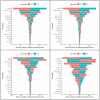Xpert Ultra stool testing to diagnose tuberculosis in children in Ethiopia and Indonesia: a model-based cost-effectiveness analysis
- PMID: 35777870
- PMCID: PMC9252203
- DOI: 10.1136/bmjopen-2021-058388
Xpert Ultra stool testing to diagnose tuberculosis in children in Ethiopia and Indonesia: a model-based cost-effectiveness analysis
Abstract
Objectives: The WHO currently recommends stool testing using GeneXpert MTB/Rif (Xpert) for the diagnosis of paediatric tuberculosis (TB). The simple one-step (SOS) stool method enables processing for Xpert testing at the primary healthcare (PHC) level. We modelled the impact and cost-effectiveness of implementing the SOS stool method at PHC for the diagnosis of paediatric TB in Ethiopia and Indonesia, compared with the standard of care.
Setting: All children (age <15 years) presenting with presumptive TB at primary healthcare or hospital level in Ethiopia and Indonesia.
Primary outcome: Cost-effectiveness estimated as incremental costs compared with incremental disability-adjusted life-years (DALYs) saved.
Methods: Decision tree modelling was used to represent pathways of patient care and referral. We based model parameters on ongoing studies and surveillance, systematic literature review, and expert opinion. We estimated costs using data available publicly and obtained through in-country expert consultations. Health outcomes were based on modelled mortality and discounted life-years lost.
Results: The intervention increased the sensitivity of TB diagnosis by 19-25% in both countries leading to a 14-20% relative reduction in mortality. Under the intervention, fewer children seeking care at PHC were referred (or self-referred) to higher levels of care; the number of children initiating anti-TB treatment (ATT) increased by 18-25%; and more children (85%) initiated ATT at PHC level. Costs increased under the intervention compared with a base case using smear microscopy in the standard of care resulting in incremental cost-effectiveness ratios of US$132 and US$94 per DALY averted in Ethiopia and Indonesia, respectively. At a cost-effectiveness threshold of 0.5×gross domestic product per capita, the projected probability of the intervention being cost-effective in Ethiopia and Indonesia was 87% and 96%, respectively. The intervention remained cost-effective under sensitivity analyses.
Conclusions: The addition of the SOS stool method to national algorithms for diagnosing TB in children is likely to be cost-effective in both Ethiopia and Indonesia.
Keywords: epidemiology; health economics; infectious diseases; paediatric infectious disease & immunisation; tuberculosis.
© Author(s) (or their employer(s)) 2022. Re-use permitted under CC BY. Published by BMJ.
Conflict of interest statement
Competing interests: None declared.
Figures



References
-
- World Health Organization . Global tuberculosis report 2019, 2019. Available: https://www.who.int/teams/global-tuberculosis-programme/tb-reports/globa...
-
- World Health Organization . Roadmap towards ending TB in children and adolescents 2018. Available: https://apps.who.int/iris/bitstream/handle/10665/274374/9789241514668-en...
-
- World Health Organization . Rapid communication: molecular assays as initial tests for the diagnosis of tuberculosis and rifampicin resistance, 2020. Available: https://www.who.int/publications/i/item/9789240000339
Publication types
MeSH terms
LinkOut - more resources
Full Text Sources
Medical
